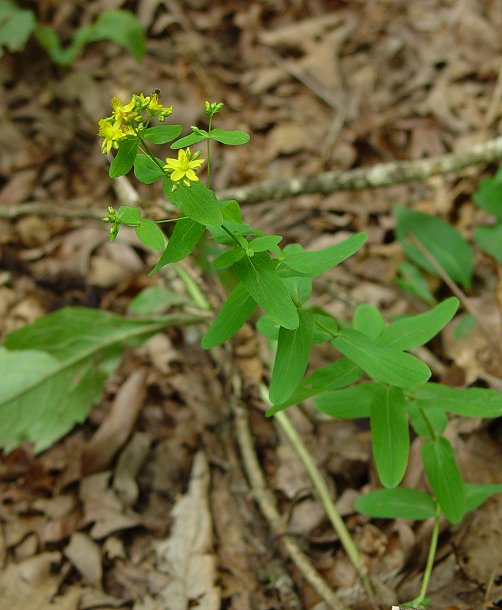Hypericum punctatum Lam.
Spotted St. John's-Wort

Native
CC = 3
CW = 0
MOC = 83
© DETenaglia
Hypericum punctatum Lam.Spotted St. John's-Wort | |
 |
Native CC = 3 CW = 0 MOC = 83 |
© DETenaglia |
|
Family - Hypericaceae Habit - Perennial forb, the rootstock and stem bases often somewhat woody, often with short to long rhizomes. Stems - Ascending to erect, to 1.0 m, single or multiple, usually unbranched below the inflorescence, rounded or bluntly and inconspicuously angled below, green to more commonly reddish brown and usually with noticeable yellowish brown or black dots, lines, and/or streaks. Leaves - Opposite, sessile, simple, not jointed at the base. Blades 10-55 mm long, 4-20 mm wide, oblong-elliptic to narrowly oblong or oblanceolate, rounded to less commonly bluntly pointed at the tip, narrowed or rounded to shallowly cordate at the base, sometimes somewhat clasping the stem, herbaceous in texture, with mostly 1 main vein visible toward the base, the margins entire and flat or less commonly slightly rolled under, the surfaces with usually many noticeable yellowish brown to dark green or black dots, the upper surface green, the undersurface paler but only rarely slightly glaucous.
Inflorescence - Terminal panicles of 10-200 flowers, rounded to more or less flat-topped in outline. Peduncles to 1.5 cm, with multiple black glandular punctations. Flowers sessile or short-pedicillate, each subtended by a small linear bract to 3 mm long.
Flowers - Actinomorphic. Sepals 5, all similar in size and shape, 2.5-4.0 mm long, elliptic-lanceolate, the margins flat, with abundant noticeable black dots, lines, or streaks (additional inconspicuous yellowish brown to dark green dots, lines, or streaks may be present). Petals 5, 4-8 mm long, oblanceolate to oblong-elliptic, orangish yellow to bright yellow or less commonly lemon yellow, with abundant yellowish brown to black dots, lines, and/ or streaks occurring irregularly across the entire surface, withered and inconspicuous but usually persistent at fruiting. Stamens 25-55, the filaments occasionally fused inconspicuously into 3 or 5 groups toward the base. Ovary completely 3-locular, the placentation axile. Styles 3, free above the base, more or less spreading, persistent, the stigmas capitate.
Fruits - Capsules 4-6 mm long, ovoid, widest below the midpoint, tapered to the minute beaks, bluntly triangular to more or less circular in cross-section, the surface usually with abundant yellowish brown dots and/or lines. Seeds numerous, 0.6-0.9 mm long, the surface with a fine network of ridges and pits, sometimes appearing inconspicuously longitudinally ribbed, light brown to brown. Flowering - June - September. Habitat - Bottomland and mesic forests, streambanks, prairies, glades, bluffs, fields, pastures, ditches, railroads, roadsides, open disturbed areas. Origin - Native to the U.S. Other info. - This is one of the more common members of the genus in Missouri, occurring nearly statewide and tolerating a wide variety of habitats. Its range extends throughout the eastern half of the continental U.S. All common members of the genus have pellucid (membranous and translucent) dots on the leaf surfaces. This species is also characterized by numerous black spots scattered across the entire leaf and flower petal surfaces. The petals are 4-8 mm long. The leaves sometimes turn a brilliant reddish-purple with age. Photographs taken in the Ozark Scenic Riverways, Shannon County, MO., 7-1-03 (DETenaglia); also at Pacific Palisades Conservation Area, MO, 8-1-2009, and at Matson Hill County Park, St. Charles County, MO, 6-22-2021 (SRTurner). |